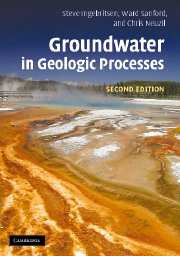Book contents
- Frontmatter
- Contents
- Preface
- Acknowledgements
- List of symbols
- 1 Groundwater flow
- 2 Hydromechanical coupling
- 3 Solute transport
- 4 Heat transport
- 5 Regional-scale flow and transport
- 6 Ore deposits
- 7 Hydrocarbons
- 8 Geothermal processes
- 9 Earthquakes
- 10 Evaporites
- 11 Compaction and diagenesis
- 12 Metamorphism
- 13 Subsea hydrogeology
- References
- Index
2 - Hydromechanical coupling
Published online by Cambridge University Press: 12 January 2023
- Frontmatter
- Contents
- Preface
- Acknowledgements
- List of symbols
- 1 Groundwater flow
- 2 Hydromechanical coupling
- 3 Solute transport
- 4 Heat transport
- 5 Regional-scale flow and transport
- 6 Ore deposits
- 7 Hydrocarbons
- 8 Geothermal processes
- 9 Earthquakes
- 10 Evaporites
- 11 Compaction and diagenesis
- 12 Metamorphism
- 13 Subsea hydrogeology
- References
- Index
Summary
Although it was not considered in detail, the mechanical interaction between groundwater and the porous geologic media it permeates is central to the phenomenon of groundwater flow discussed in the preceding chapter. In this chapter we consider this hydromechanical coupling in greater depth. Hydromechanical coupling is a two-way street; not only can deformation of geologic media affect groundwater pressure and flow, changes in groundwater pressure can deform rocks and sediments and cause them to fail mechanically. These important interactions underlie phenomena as diverse as sediment compaction, anomalous fluid pressures, fracturing, and seismic slip.We begin this chapter by considering how to describe elastic deformation in water-saturated geologic media, and show how this leads to the theory of poroelasticity, which describes the interaction between fluid pressure and deformation of elastic porous materials, such as certain geologic media, in three dimensions. Deformation of geologic media is often too complex to describe with elastic models, however, so more general inelastic rheologies, or styles of deformation, are also discussed. These more general poromechanical theories permit rigorous descriptions of hydromechanical coupling, but often geologic systems are too poorly understood to take full advantage of the rigor they offer. The final part of this chapter considers simplifications and shortcuts that, when applied to geological problems, yield considerable insight into the hydromechanical workings of geological processes.
Hydromechanical equations
Two types of forces, body forces and surface forces, act on solids. The only body force of any consequence in geologic problems is gravity and, for reasonswe will discuss later, it will not be an important consideration here. Surface forces are most usefully characterized in terms of stress, or force per unit area. The term “surface” in this context can be a bit confusing, because it refers to both actual surfaces such as the ground surface or a formation boundary, and to virtual surfaces with arbitrary orientations anywhere within a solid.
For this discussion, it will be useful to have a way of describing stresses and resulting distortions and volume changes in solids, which are termed strains. Figure 2.1 depicts a block of rock subjected to normal stresses (acting perpendicular to the faces) and shear stresses (acting parallel to the faces).
- Type
- Chapter
- Information
- Groundwater in Geologic Processes , pp. 38 - 88Publisher: Cambridge University PressPrint publication year: 2006

